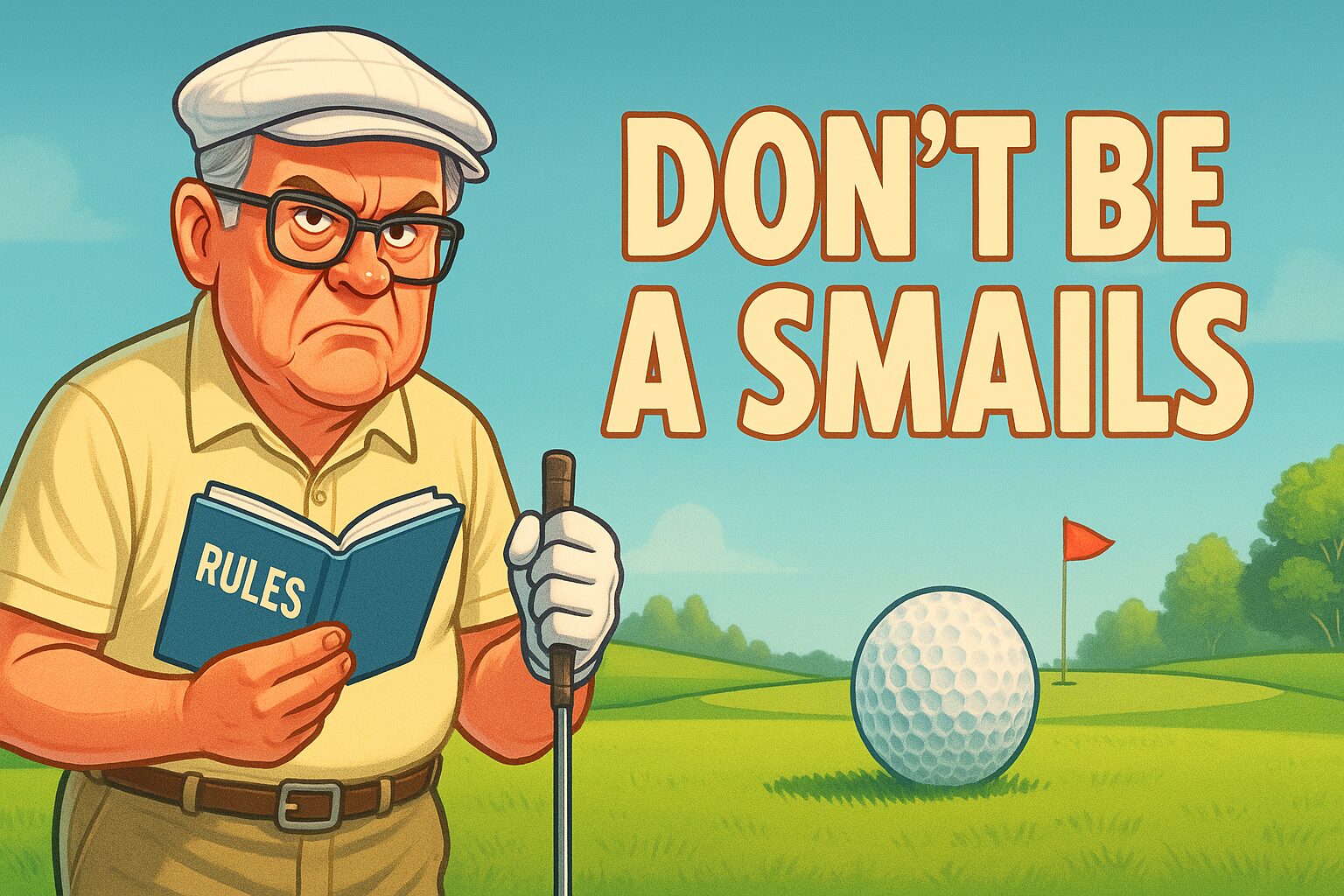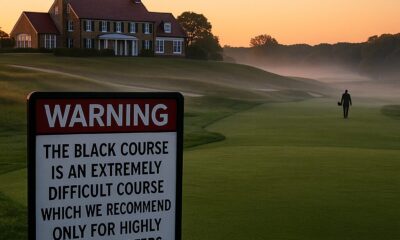Blog
Weekly Breakdown: Rory’s contentious decision, Torrey Pines props, and shaky putting

Welcome back to the Weekly Breakdown, where we’re wondering if Tom Brady is getting out now to give himself a few years to get ready for the Champions Tour… Let’s get to it!
FIRST GROUP OFF
Torrey Pines.
There is a contingent of diehard golf fans who have a notably complex relationship with Torrey Pines. There are a handful of gripes with varying levels of legitimacy, which include the following: It’s boring. It doesn’t take advantage of its surroundings. Narrow fairways and long rough are meh. The greens are bumpy. There are a bunch of forgettable holes that generally just blend into each other. The pond on 18 is silly and makes zero sense in the context of the rest of the course. And then there’s the big one: Given the breathtaking cliffside property, it should be so much better.
I’m not saying those arguments are without merit. At last summer’s U.S. Open I even found myself thinking that a major championship should be held at a course that was less familiar and more exciting. But this week, in the PGA Tour’s third trip to Torrey Pines in 12 months, I found myself fully enjoying the viewing. What gives? A number of factors. Here are a few nice things I’d like to say about this week’s Tour site:
There is no course that has benefitted more from the widespread use of drone shots than Torrey Pines, which can look drab and scrubby from ground level but magnificent with proper perspective. It’s fun to have a PGA Tour course where bogeys lurk around every corner. Showcasing one of the greatest municipal golf complexes in the world on a yearly basis is a good thing for golf. There are a few holes in particular — 3, 4, 12 and 18 come first to mind — that make for terrific entertainment. The leaderboard is always bunched with solid ballstrikers coming down the back nine in the final round. And we’re deeply familiar with the finishing stretch, with memories dating back to Tiger Woods at Buick Opens, various national championships, crowning moments for Jason Day and Jon Rahm and more. That intimate knowledge of fairways, green complexes, drama, pitfalls — it all makes for better viewing. Maybe it’s Stockholm Syndrome. Maybe it’s the fact that all you need for a good Tour event is a close finish on a hard, familiar course. Whatever it is, the Farmers Insurance Open was fun.
WINNERS
Who won the week?
Viktor Hovland’s jinx
This week’s golf was chock-full of nail-biting finishes but the hottest finish came from Viktor Hovland, who seemed out of contention beginning the day six shots back and seemed further out of contention when he bogeyed No. 15 but then finished birdie-eagle-birdie to plant a flag in the clubhouse at 12 under and then deliver a top-notch jinx to his biggest threat:
“There’s some drama, there’s some water, but I mean, Rory [McIlroy] is a pretty good player, so I’m thinking he’s going to close this one off,” Hovland said as he waited. The rest is history — and more on that later.
Looks like Hovland got Rory with the mega-jinx: pic.twitter.com/D2Zw5y9D6L— Dylan Dethier (@dylan_dethier) January 30, 2022
A reporter asked Hovland if the finish was the best of his career, and he gave a curious qualifier in his answer.
“Under the circumstances, yes, for sure,” he said. What did that mean? Hovland clarified:
“I do distinctly remember a little match that I had in college. We used to do a little Ryder Cup — me and Kristoffer Ventura against Zach Bauchou and Sam Stevens. We were basically playing for dinner and it was kind of getting dark, like this, and it was pretty feisty. We all didn’t want to lose and I remember we were doing stroke-play best-ball, I think, and we were down I think three strokes with three to go, and I finished birdie, birdie, and then eagle on the last to beat them by a shot and they were so mad, and it just brought me so much joy. So I do remember that one.”
The reporter pointed out that this win — worth more than $1.3 million — was more lucrative than a dinner bet.
“It is. But the other one was pretty satisfying, too.” No wonder people like this guy.
Lydia Ko’s latest chapter
It remains hard to fathom, but Lydia Ko — winner of this week’s Gainbridge LPGA — is still just 24. That’s difficult to comprehend because she became world No. 1 at just 17, which means she has already played a lengthy professional career, but it’s also hard because that career has had so many chapters. Early success. Then some struggles. Caddie changes, coaching changes, team changes. And now, with 17 wins under her belt, Ko has validated her comeback tour and cemented herself among the top pros in the world. Since the beginning of 2021, Ko has made 24 starts, missing just one cut while logging 16 top-10s, nine top-threes and three victories. She’s solidly at No. 3 in the world behind the dueling duo of Jin Young Ko (back at No. 1 after this wee
Lydia Ko became a 17x LPGA Tour winner with a final round 69 at the @GainbridgeLPGA ?
Watch her highlights from Sunday in Boca! ? pic.twitter.com/20R0DlkX7l— LPGA (@LPGA) January 31, 2022
On Sunday, Ko held off Danielle Kang with a clutch up-and-down from a greenside bunker at No. 18. Post-round she reminded everyone that you can’t try to be a past version of yourself; neither life nor golf works that way. And she summed up her feelings succinctly:
“Three words: Excited, cocktail, sleep,” she said. “I’m a little — I could do with sleep right now, thank you. I had a cocktail. That’s why I said cocktail. I feel like my cheeks are getting red, too.”
Well earned.
Luke List’s horrendous layup
This sounds like a dig but it is, in fact, admiration. Luke List came to No. 18 at Torrey Pines reeling; he’d just missed a four-footer at No. 17 to fall a shot off the lead. Then he missed left with his tee shot, forcing a layup so that he could get it close to the front-left funnel pin. But then he committed the cardinal sin of Torrey Pines: He layed up into the rough.
But then we saw the benefit of List being a terrific ball-striker and a very strong human being. Even from the rough he was able to generate enough spin that his ball landed softly on the front of the green and settled some 13 feet from the hole. He matched speed with line perfectly, making birdie to force a playoff. And in that playoff, he hit an even better layup from a worse lie (plugged in the right fairway bunker) and followed that with an even better approach shot, which he spun back to inside a foot. That made him a winner. And it was pretty clear just how much that win meant:
Follow along behind the scenes with Luke List after securing his first victory on TOUR @FarmersInsOpen ? pic.twitter.com/zdxKYjpmVZ— PGA TOUR (@PGATOUR) January 31, 2022
ALMOST-WINNERS
So close, and yet…
Danielle Kang’s tunnel vision
Coming off a win at the Tournament of Champions, Danielle Kang nearly made it two in a row — but her birdie try at No. 18 just wiggled past. Kang and Ko dueled their way down the stretch but Kang credited her charge in part to staying in her own lane.
“I wasn’t necessarily paying attention to a lot of what [Ko] was doing, to be honest, because I didn’t even know on 12 she had to hit a provisional because I got up to the fairway and there was four golf balls and I said, What happened here?”
Richard Bland, Ageless Wonder
If it’s possible for a playoff loss to feel like a win, how ’bout the runner-up finish for Richard Bland at the Dubai Desert Classic? As a quick recap: He’s turning 49 next week, he’s up to No. 53 in the world, Viktor Hovland needed 73 holes to beat him and, given the strength of the field, the finish registers as his best-ever result in terms of World Ranking points.
Will Zalatoris (and yes, his putter too)
The wobbly putting stroke of Will Zalatoris was front and center this weekend, largely on the basis of one sketchy missed shortie and two missed putts on 18 (one in regulation, one in the playoff). Let’s attempt something challenging: Let’s try to hold two thoughts in our head at the same time. Will Zalatoris’ putting woes might be real and might also be overstated.
Viewer discretion is advised. https://t.co/gTFPPhUDBv— No Laying Up (@NoLayingUp) January 28, 2022
Tee to green, Zalatoris was the best golfer in the field, gaining an extremely impressive 12.5 strokes. On the greens, he was a troubling 64th of the 79 players who made the cut, and he made nothing on Saturday, taking 29 putts on the 15 greens he hit in regulation. He actually made very little on Saturday, too, when he hit it so well he shot seven-under 65 despite losing ground on the greens. That basically never happens.
So the putting isn’t great. No doubt about that. It wasn’t great either, when Zalatoris finished the season No. 122 on Tour in putting, which is below average but well ahead of other notables like Hideki Matsuyama (who won the Masters) and Collin Morikawa (who won the Open Championship and conquered the world).
But let’s remember what Brandel Chamblee said a couple weeks ago in reference to Matsuyama:
“It’s not about who putts the best. It’s about who putts best, amongst the best ball strikers. And when [Hideki] does that he always has a decent chance.”
Zalatoris was a couple of inches from winning last week. If he keeps hitting the ball like this, he’ll have a whole bunch more chances.
So, so close.
Will Zalatoris and Luke List are headed for a playoff. pic.twitter.com/Ah9XeXd0DY— GOLFonCBS (@GOLFonCBS) January 30, 2022
Jason Day’s chase for No. 1
Even as he has dropped steadily in the world rankings, Jason Day has continued to talk about the goal of returning to World No. 1. I’ve admired his ability to think big, given he entered this week at World No. 129. But his game was solid through the bag, he turned in a vintage putting performance and contended until the end, finishing one shot outside the playoff and posting his first top-three finish since 2018.
Jon Rahm’s grip on World No. 1
All last week, Jon Rahm looked, uhh, unsatisfied with his game.
Jon Rahm just beat the tee box so hard he broke out the ball mark repair tool! pic.twitter.com/tY0hIE4IR3— Dylan Dethier (@dylan_dethier) January 27, 2022
He still had a putt on the 72nd hole to get into a playoff. I’m starting to think he’s pretty good.
NOT-WINNERS
Maybe next week?
Not laying up
Rory McIlroy seemed destined for victory when he stepped to the 17th tee on Sunday tied for the lead with a drivable par-4 and reachable par-5 in front of him. But a messy tee shot on 17 left him scrambling for par and then he laid back with 3-wood off the tee on 18, forcing a difficult decision: From 267 yards, should he pull 3-wood and go for the green? Or should he lay up, try to wedge it close and, if he made par, get into a playoff?
After the fact, the wise golf minds of the internet seemed unanimously incredulous that McIlroy went for it (and dumped it way short, at least 10 yards shy of clearing the water). I actually think his decision to go for it was reasonable, at least at the outset. If he clears the water, he’s very likely making birdie and leaving with the win. If he lays up, birdie is in play, but it’s far less likely — plus par means a three-man playoff and bogey is still in play, too, given McIlroy’s occasional misadventures with a wedge. Plus, McIlroy still had that same wedge shot to get up-and-down for par and force a playoff, so the back-door win was still available.
Instead, I’d say the mistake was in the execution as much as it was the decision to go for it. Perhaps there was mud on the ball that affected its flight. Perhaps he and caddie Harry Diamond misjudged the wind. Either way, you just can’t hit the high, slicey soft one there. He did, and it cost him the tournament.
Justin Thomas’ weekend
On Friday, we seemed destined for a Jon Rahm-Justin Thomas duel in the final round. But that never quite materialized. Yes, Rahm stayed in the hunt, but Thomas disappeared in a peculiar way, making seven bogeys against just three birdies in his final 27 holes to finish T20. It’s tough to pinpoint one issue in particular, because Thomas hit some loose tee shots in the third round while his short game seemed the main culprit on Saturday, losing three shots to the field around and on the greens. Thomas’ weekend isn’t cause for worry — he entered the week with five top-six finishes in his last seven starts — but it does feel like a missed opportunity.
Bleach-blond Brooks
I’m a big fan of Brooks Koepka’s new hair color and his general willingness to do something people will make fun of him for doing. But I think if you go hard on the bleach-blond hair you have to make the cut, right?!
Brooks Koepka looks like he ate Will Zalatoris pic.twitter.com/p92yxKMdSk— Dylan Dethier (@dylan_dethier) January 27, 2022
Koepka went all Marshall Mathers before Wednesday’s opening round, but come Friday he shot 74 in his second round to miss the weekend by three. The good news for Koepka: He had plenty of company! Bryson DeChambeau, Jordan Spieth, Tony Finau, Rickie Fowler and Phil Mickelson were among the list of big names to miss the weekend.
This article originally appeared on Golf.com
Blog
Weather and the Game: The Undeniable Influence of Elements on Championship Outcomes
Learn how weather affects different championship outcomes.

Introduction
As a sports enthusiast, you might have noticed that weather plays a significant role in sporting events, particularly in championships. From the power of a baseball pitch to the course of a golf ball, from the strength of a football kick to the stride of a marathon runner – the elements can influence each of these and more. In this article, we delve into the fascinating intersection of meteorology and sports, examining how weather conditions can make or break a championship game.
The Impact of Weather on Different Sports
Whether it’s football, baseball, golf, tennis, or marathon, each sport faces unique challenges when it comes to weather. Let’s delve into the specifics:
Football and Weather Elements
Football is a sport that’s played in almost all weather conditions except for severe ones like lightning storms. However, weather elements have a significant impact on the game.
-
- Rain: A wet field makes the ball slippery, impacting players’ ability to handle, pass, or kick the ball accurately. Rain can also make the field muddy, affecting the players’ ability to move swiftly.
- Wind: Strong wind can alter the trajectory of the ball, affecting passes and kicks.
- Cold: Extremely cold temperatures can affect players’ physical performance and endurance, while also making the ball harder and more challenging to catch.
Baseball and Weather Elements
Baseball is another sport where weather conditions can significantly influence the outcome.
-
- Wind: The direction and speed of the wind can affect the trajectory and distance a baseball travels.
- Humidity: High humidity can make the ball denser, potentially reducing its bounce and speed.
- Temperature: Low temperatures can make the ball harder, affecting its bounce and the players’ ability to grip and hit it effectively.
Golf, Tennis, and Marathons
Weather conditions play an equally crucial role in golf, tennis, and marathons.
-
- Wind: In golf, the wind can alter the ball’s direction and distance. In tennis, wind can affect ball control, altering serves and volleys.
- Temperature: Extreme heat can affect a marathon runner’s performance significantly, leading to dehydration and exhaustion.
- Rain: In golf, a wet course can slow down the ball, while in tennis, a wet court can make the ball bounce irregularly.
Case Studies: Weather Influencing Championship Outcomes
This section presents some examples of games where weather conditions significantly influenced the outcome.
- The “Ice Bowl” (1967): The NFL Championship game between the Green Bay Packers and the Dallas Cowboys, often referred to as the “Ice Bowl,” witnessed one of the coldest conditions in NFL history, affecting players’ performance and the final outcome.
- The “Windy City” World Series (1945): The World Series game between the Chicago Cubs and Detroit Tigers was so affected by the wind that it changed the trajectory of the baseball multiple times, influencing the game’s final score.
- Wimbledon Championships (2019): The final match between Novak Djokovic and Roger Federer was played with the Centre Court’s roof closed due to rain, limiting the natural elements’ effects and perhaps altering the match’s dynamics.
Conclusion
The impact of weather on sports is an exciting field of study, revealing how the natural elements influence games and championships. From altering the trajectory of a ball to affecting a player’s physical performance, weather can indeed be a game-changer. As fans and enthusiasts, understanding these influences can add another layer of excitement and anticipation to our favorite sports.
So the next time you attend or watch a game, remember to check the weather forecast. It might just give you a sneak peek into the game’s possible outcome!
Blog
The Unofficial Rules of Golf: A Gentleman’s Guide to Not Being Judge Smails
The official rulebook is thicker than a dictionary and twice as boring. Let’s talk about the rules that really matter on the course: how to have fun, respect the game, and not be a stick-in-the-mud. Hint: It involves less plaid and more cosmic harmony.

You’ve seen him. I’ve seen him. The guy who quotes the USGA rulebook like it’s scripture. He’ll happily tell you your ball moved a quarter of an inch when you addressed it, costing you a penalty stroke. He’s got a plumb bob for a three-foot putt and the personality of a rake. He is, in spirit, Judge Smails. And let’s be honest, nobody wants to be Judge Smails.
The real game of golf, the one that keeps us coming back, isn’t played by those rules. It’s played by a higher law. An unwritten code of conduct that’s all about flow, friendship, and the pursuit of that one perfect shot. It’s a gentleman’s agreement with the universe.
So, let’s talk about the rules that actually matter.
1. The Cosmic Readjustment (aka The Mulligan). Your first tee shot is a mess. It goes sideways into the woods where the gophers play. The Smails of the world would tell you to take a penalty and hack it out. I say the universe is just getting warmed up. The “breakfast ball” isn’t cheating; it’s a course correction. It’s an agreement among friends that a round of golf shouldn’t be ruined before it even begins. Take another. The Dalai Lama would want you to.
2. The Art of Flow (aka Pace of Play). This isn’t about rushing. Rushing is a fool’s game. This is about flow. It’s about being ready to hit when it’s your turn. It’s about watching your friend’s shot so you can help them find it. It’s about moving with a purpose, not like you’re searching for your car keys in a dark parking lot. Don’t be the anchor that drags the whole group down. See the line, hit the ball, walk on. Nanananana.
3. The Circle of Friendship (aka Gimmes). Is the putt inside the leather? Good enough. Pick it up. Life is too short to watch your buddies sweat over an 18-inch putt for a double bogey. A gimme isn’t just a time-saver; it’s a gesture of goodwill. It says, “I trust you, you trust me, and neither of us needs the anxiety of missing this tiny putt.” It’s good for the karma, and even better for the pace of play.
4. The Final Verdict (aka The 19th Hole). The most important rule is this: no matter what happened out there, you shake hands on the 18th green and settle things over a cold drink at the 19th. The guy who shot an 82 and the guy who shot a 102 are equals in the clubhouse. The stories get better, the putts get longer, and the bad shots fade away. This is where the real game is won.
So, forget about the fine print. Focus on the feeling. Be a good playing partner, enjoy the walk, and don’t be a Smails. You’ll find your score starts to take care of itself.
Did this speak to your soul? Pass it along to your foursome to make sure everyone is on the same page. For more deep thoughts from the fairway, be sure to follow us on social media. It’s the right thing to do.
Blog
When Golf Gadgets Fail: Navigating Common Tech Mishaps on the Golf Course
A Look at What Happens When Modern Golf Gadgets Go Wrong

Imagine this: you’re on the golf course, teeing off on a beautiful, sunny day. With the help of your trusty golf gadget, you’re confident you’ll hit a birdie or even an eagle. But just when you’re about to swing, your gadget malfunctions. Suddenly, your perfect game is thrown into chaos. Welcome to the world of technology fails, where even the most advanced golf devices can sometimes let you down. In this article, we’ll explore some common tech fails and provide some tips on how to handle them.
When Golf Gadgets Let You Down
Modern golf devices, from smart clubs to digital scorecards to GPS-enabled watches, have revolutionized the game. They provide golfers with real-time data, helping them refine their swing, choose the right club, and navigate the course. But what happens when these devices fail?
Unreliable Data
One of the most common golf gadget fails is inaccurate or unreliable data. GPS devices might show the wrong distance to the pin, swing analyzers might give incorrect feedback, and digital scorecards might miscalculate your score. This can be frustrating, especially when you’re relying on these devices to improve your game.
Battery Drain
Another common issue is battery drain. Many golf gadgets require a significant amount of power, and if they’re not properly charged, they can die in the middle of a game. This leaves you without the data you need to make informed decisions on the course.
Technical Glitches and Malfunctions
Sometimes, golf devices just stop working. They might freeze, crash, or refuse to turn on. These technical glitches can be caused by software bugs, hardware issues, or even user error.
Preventing Golf Gadget Fails
While it’s impossible to prevent all golf gadget fails, there are steps you can take to minimize the risk.
Regular Updates
Keeping your devices updated can help prevent software-related issues. Regular updates often include bug fixes and improvements that can enhance the performance of your device.
Proper Charging
To avoid battery-related problems, make sure to fully charge your devices before hitting the course. Some devices also have power-saving modes that can help extend battery life.
Backup Plan
It’s always a good idea to have a backup plan in case your devices fail. This might mean carrying a traditional scorecard or having a basic understanding of how to calculate distances without a GPS.
When Gadgets Go Wrong: The Bottom Line
Golf gadgets are a fantastic tool for any golfer looking to improve their game. However, like all technology, they can sometimes fail. By understanding the common issues and how to prevent them, you can ensure you’re prepared for any tech-related hiccups on the course. After all, golf is about more than just the gadgets—it’s about the experience, the skill, and the love of the game.
-

 Product Review6 years ago
Product Review6 years agoThe Perfect Practice Putting Mat Review by Jason Tenzer
-

 Blog4 years ago
Blog4 years agoLoophole Rule Offers PGA Tour Pros a Mulligan
-

 Blog4 years ago
Blog4 years ago2021 Buyer’s Guide: The Top 10 Value Golf Balls For Distance & Feel
-

 Blog5 years ago
Blog5 years agoGolf Marriage Counselor
-

 Blog6 years ago
Blog6 years ago9 Biggest Chokes Of The Past Decade
-

 Product Review6 years ago
Product Review6 years agoTHE ADJUSTABLE IRONS: WALKING STICKS GOLF CLUBS
-

 Blog4 years ago
Blog4 years agoWhat Your Golf Clubs Say About You
-

 Equipment6 years ago
Equipment6 years agoOHK Sports Interview by Jason Tenzer






























